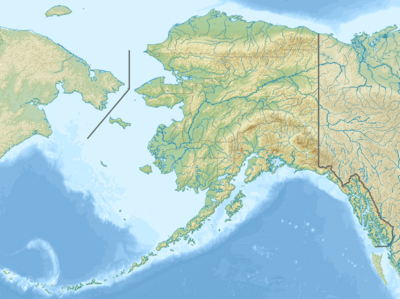Eagle Peak (Admiralty Island)
Eagle Peak is a prominent 4,650-foot (1,417 m) elevation mountain summit located on Admiralty Island in the Alexander Archipelago, in the U.S. state of Alaska. It is the second-highest peak on the island, and is situated 14 mi (23 km) southwest of Juneau, within Admiralty Island National Monument, on land managed by Tongass National Forest. Although modest in elevation, relief is significant since the peak rises up from tidewater at Stephens Passage in 4.5 mi (7 km). This geographic feature's local name was published by the U.S. Geological Survey in 1951.[2][4]
| Eagle Peak | |
|---|---|
 Eagle Peak seen from Douglas Island | |
| Highest point | |
| Elevation | 4,650 ft (1,420 m) [1] |
| Prominence | 2,900 ft (880 m) [1] |
| Parent peak | Admiralty Island High Point[1] (4,850 ft) |
| Isolation | 18.33 mi (29.50 km) [1] |
| Coordinates | 58°06′49″N 134°32′44″W [2] |
| Geography | |
 Eagle Peak Location of Eagle Peak in Alaska | |
| Location | Admiralty Island National Monument Hoonah-Angoon Alaska, United States |
| Parent range | Alexander Archipelago[2] Pacific Ranges[3] |
| Topo map | USGS Juneau A-2 |
| Climbing | |
| Easiest route | class 4 scrambling[1] |
Climate
Based on the Köppen climate classification, Eagle Peak has a subarctic climate with cold, snowy winters, and mild summers.[5] Weather systems coming off the Gulf of Alaska are forced upwards by the mountains (orographic lift), causing heavy precipitation in the form of rainfall and snowfall. Temperatures can drop below −20 °C with wind chill factors below −30 °C. The month of July offers the most favorable weather for viewing or climbing Eagle Peak.
References
- "Eagle Peak - 4,650' Alaska". listsofjohn.com. Retrieved 2020-04-12.
- "Eagle Peak". Geographic Names Information System. United States Geological Survey. Retrieved 2020-04-12.
- "Eagle Peak, Alaska". Peakbagger.com. Retrieved 2020-04-12.
- Dictionary of Alaska Place Names, Donald J. Orth author, United States Government Printing Office (1967), page 293
- Peel, M. C.; Finlayson, B. L. & McMahon, T. A. (2007). "Updated world map of the Köppen−Geiger climate classification". Hydrol. Earth Syst. Sci. 11. ISSN 1027-5606.

External links
- Weather forecast: Eagle Peak